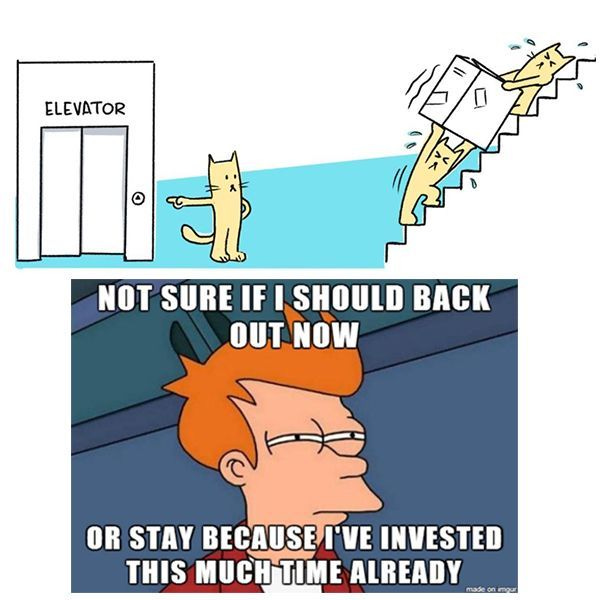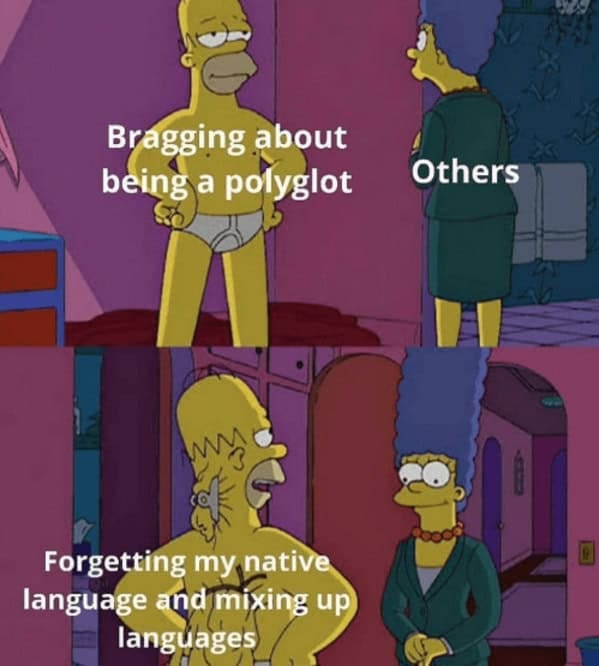Maintenance costs
Taking care of the rust regularly
Welcome, aspiring polyglot! Learning the language is not the final step. However, the fear mongering that most people face when they begin learning something new is detrimental to everyone. Maintaining is far easier than learning and whether you realize it or not, maintaining is actually fun. Learning involves exponentially more failure. Maintenance means swapping out a few things you do in your native language to start doing those things in your target language.
Sunk cost fallacy
Use it or lose it. That’s what we hear from the second we start learning a new language. Believe it or not, the vast majority of the time someone says that to you, they are not doing it to scare you off learning a new language, they are saying it to justify not putting the work in themselves. After all, if you can’t see yourself using the new language indefinitely, why even bother with such an endeavor? At least, that is the rationale I have heard all too often.
It is true that when you do not use your language you get rusty. But in order for there to be rust, there must be something there to rust. The idea that your language skills completely disappear, even years after your acquisition, is laughable. Your brain is extremely powerful. It does not simply toss things into the trash because you are not currently using them. Almost universally, my students are shocked at how much the language classes they took decades ago serve them in their current day language acquisition.
All you really have to do is take time weekly or, ideally, daily to knock the rust off. Something as simple as knocking out 5 Duolingo lessons is enough to remind your brain that you need this information, so don’t store it away just yet. That said, the more time you wait to knock off the rust, the more time it has to build up and it will take longer for you to shake it off. Don’t wait for the build up to happen, start maintaining now if you have been putting it off.
Maintenance is easier than learning. At the end of the day, if you want another language in your life, but you don’t have the time to commit to learning a new one, taking care of the rust on any languages you do know is the perfect way to spend your time until you have the opportunity to take on another language. Not only is maintenance easier than learning, it is also different. Your goals, the approach, what success looks like. All of things depend on whether you are seeking to maintain or acquire the language.
Maintenance dues
Language acquisition takes significantly more effort than language maintenance. Learning is more difficult than remembering, in short. What does that mean for you, though? Simple. The daily and weekly work requisite to maintain the language(s) you know is a fraction of the time required to learn a new one altogether. That means during the times when you are absolutely swamped, and those will come, you can shift your focus from acquisition to maintenance.
Wins look different between these two. If you want a look at what wins look like for language acquisition, check out this article:
How to Know You're Winning
Welcome, budding polyglot! As I am certain you know, one of the most frustrating aspects of learning a new language is that there are times when it feels like absolutely no progress is being made. Weeks on end where it feels like the same subjects and material are being covered incessantly. I have felt this way with every language I have tried to learn …
On the other hand, here are what I would consider the wins of language maintenance:
Daily Work
1-5 Duolingo/Pimsleur/Glossika/Babbel lessons (try to test to the highest possible level so you are not just repeating things you know)
1-5 sentences about your day. Think about what you are going through. Forget the linguistic aspect, documenting overwhelming times has dual benefits: First, it demystifies things. While the amount to be done remains unchanged, the path forward becomes more clear. Second, once you make it through, it’s nice to look back at how you were feeling at the time and what you drew on to push through. Powerful words for when you are facing difficult times in the future.
30 minutes of audio only. When I say only I mean only. Do not look up words, if a phrase passes by you, let it go. The whole goal of this is exposure, not learning new things. Just have something on in the background. Music, a podcast, a YT video, TV shows even.
BONUS: Read 1 chapter in a book of your choice every night
Estimated time: 45 minutes/day
A Good Week
Here is what a good week looks like:
20 sentences
21 Duolingo lessons (with skips as necessary)
3.5 hours of passive audio exposure
BONUS: Read 5 chapters in a book of your choice
It may not seem like much, but it is more than sufficient to maintain the language you know. If you have a little extra time on your hands, you can take all of this to the next level by simple documenting every new word you come across. You don’t even have to translate it if you do not want to, you just have to note it down as a new word. Over time you will see them emerge multiple times and that can help you prioritize which words to commit to memory and which to learn passively.
Managing multiple languages
Now, something especially for those of you juggling 3+ languages. Language maintenance and the methodology you choose for it might just be the most important thing in your language learning journey. We all know what it is like to have one language improve at the expense of the other. It doesn’t have to be like this, though. There are maintenance strategies you can use to manage all of your languages simultaneously without hurting your progress in a new language.
The first thing you have to do is decide your maintenance routine. This is crucial because your acquisition routine will be built around it. Once the maintenance routine is in place, you can focus entirely on where to plug in acquisition time. Of course, if you can do your maintenance while doing your acquisition that’s feeding two birds with one scone. Use the language you are seeking to maintain to learn the new language. Fair warning, this is exhausting.
Let’s say, for example, you are learning French, but you speak Spanish as a second language. You could, conceivably, find videos from Spanish speakers who teach French. Here are just a few examples and the very simple prompt I used to find them:
This will work with more language than just French and Spanish, but it likely will not be possible for every language. If you are struggling to find your languages in a format like this try looking into parallel text books where the two language are presented on pages opposite one another. This makes reading through far easier and it is perfect for managing multiple languages.
I always suggest using one language to learn another for one very simple reason: delineation. As anyone who has learned multiple languages within the same linguistic family can attest to, keeping the languages separate is often the biggest challenge that we face. By using one language to learn another, you force your brain to delineate between the two in the same way it draws lines between your native language and the other languages you speak.
Anyone who has experienced this knows that line is more of a guideline than a rule, but it is still helpful when learning and maintaining languages. Managing multiple languages takes more time, but you do not have to speak every language every day in order to maintain it. Consistency is far more important. Develop a routine and divide your attention according to your personal priorities and goals within your linguistic development.
Conclusion
Years of solo traveling taught me one thing for certain: the language bug is unrelenting. Once you are bit, it becomes a mission to learn as many languages as possible. Even those who started just because they wanted to learn a language for work often end up studying 1-2 more after their initial language acquisition. While I love this for what it is, I also love it because it means job security! In all seriousness, though, this would all be far easier to outsource to a robot.
With the advent of AI, I commend you, reader, for choosing to take on the challenge of learning a new language rather than outsourcing your thinking to a machine. at the end of the day, there will never be a replacement for human connection. I promise you, the person in the business meeting who took the time to learn the language is going to get the contract over the guy using GPT to translate everything. As everything becomes AI slop, authenticity will continue to grow in value considerations.
Learning a new language is difficult. Maintaining the languages you know is difficult. Choosing to think rather than outsource to a computer is difficult. But you can do difficult things and become great. So continue to get out there and do difficult things and be great. I am rooting for you; and, in this particular case, struggling right along with you.
Requests
If you have anything you would like covered you can reach out to me on X, Instagram, or at odin@secondlanguagestrategies.com.
Additional Resources
Don't want to spend time playing catch up? Pick up the 3 Months to Conversational book now available on Amazon! 3 Months to Conversational
For more long form content be sure to check out the website and the FREE Language Learning PDFs we have available!
Subscribe for new content on YouTube and TikTok!
Learning Spanish? We have begun aggregating resources in you Spanish Resource Newsletter!
Don't forget to pick up your very own French Language Logbook or Spanish Language Logbook









